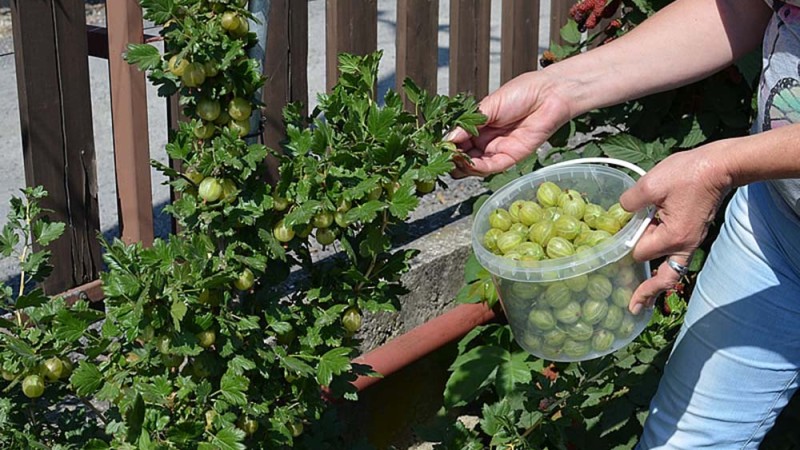
Ak chcete do svojej záhrady pridať ďalšie lahodné a výživné ovocie, nehľadajte nič iné ako egreše. Tieto malé, aromatické sladkokyslé bobule sú nielen potešením na jedenie, ale aj relatívne ľahko sa pestujú. V tomto článku vám poskytneme podrobné pokyny, ako úspešne pestovať egreše vo vašej vlastnej záhrade.
Vyberte správnu rastlinu
Pri výbere kríka egreša hľadajte osvedčenú odrodu odolnú voči chorobám z renomovanej škôlky. Mal by to byť zdravý ker pestovaný v kvetináči so silnými koreňmi, nepoškodenými listami a dobre rozmiestnenými výhonmi.
Vyhľadajte ideálne miesto
Egrešom sa darí na plnom slnku alebo v čiastočnom tieni, preto si vo svojej záhrade vyberte miesto, kde je každý deň aspoň šesť hodín priameho slnečného žiarenia. Pôda by mala byť úrodná, dobre priepustná a mierne kyslá s hodnotou pH medzi 6,0 a 6,5.
Výsadba
Kríky egrešov sa vysádzajú vo vzdialenosti 0,8-1 m v rade. Egreše na kmeni sa vysádzajú v rade vo vzdialenosti 1,0-1,2 m.
- Vykopte jamu dvakrát širšiu ako koreňový bal a dvakrát tak hlbokú ako pôvodná nádoba v ktorej rástol egreš.
- Jemne vyberte krík z nádoby a vložte ho do vykopanej jamy.
- Zasypte jamu zeminou a jemne ju utlačte, aby ste odstránili vzduchové bubliny.
- Dôkladne zalejte, aby sa pôda okolo koreňov usadila.
- Pri výsadbe neaplikujte žiadne hnojivo.
Nezabudnite, že egreše na kmeni potrebujú silný podporný kolík, ktorý sa pod váhou úrody nezlomí. Najlepšia voľba je železná tyčka s minimálnym priemerom 2 cm.
Rez a tvarovanie
Egreše sa pestujú vo forme kríka alebo na kmeni, ale v porovnaní s ríbezľami sa pestovanie na kmeni považuje za lepší tvar, ktorý umožňuje jednoduchší zber a starostlivosť. Na rozdiel od ríbezlí rodí egreš hlavne na jednoročnom dreve, preto sa musia rok čo rok vyvíjať nové výhonky.
Správny rez je nevyhnutný pre optimálny rast a tvorbu plodov v egrešoch:
- V prvom roku zrežte vrchnú tretinu každého výhonku, aby ste podporili rozvetvenie. V lete nechajte krík voľne rásť.
- V druhom roku vyberte 4 až 6 vhodne rozmiestnených silných výhonkov ako základ budúcich konárov. Ostatné výhonky odrežte od základu.
- V ďalších rokoch zvyšujte počet konárov o 2 až 3 a v ďalšom roku opäť o 2 až 3. Od 4. do 5. roku začnite s postupnou výmenou konárov ich nahrádzaním mladšími výhonkami. Skrátenie jednoročných výhonkov v ďalších rokoch spravidla nie je potrebné. Prerezávajte, aby ste zachovali otvorený a vzdušný tvar kríkov, ktorý umožní lepšiu cirkuláciu vzduchu a zníži riziko chorôb.
Hnojenie a mulčovanie
Niekoľko týždňov pred výsadbou egreša zapracujte do pôdy organickú hmotu, napríklad zelené hnojenie, kompost alebo dôkladne prehnitý hnoj. Jesenný termín je pre organické hnojenie lepší ako jarný. Vždy používajte organické hnojivo ako nevyhnutný základ a minerálne hnojivá či už vodorozpustné alebo granulované ako potrebný doplnok výživy. Kombinácia organického a minerálneho hnojiva účinne podporí zdravý rast kríka a dostatočnú produkciu ovocia. Pre aplikačné dávky sa riaďte pokynmi výrobcu.
Mulčovanie pôdy rôznym organickým materiálom pôsobí veľmi priaznivo na rast a plodnosť egrešov. Vrstvu organického materiálu tvoriaceho mulč treba v priebehu vegetácie neustále dopĺňať pretože činnosťou pôdnych makro a mikroorganizmov sa neustále zmenšuje.
Zber
V závislosti od odrody egreše zvyčajne dozrievajú od konca júna do konca júla. Bobule zberajte, keď sú úplne vyfarbené a jemne mäkké na dotyk. Zozbierané bobule sa môžu konzumovať čerstvé, použiť na koláče, džemy alebo zaváraniny alebo zmraziť na neskoršie použitie.
Choroby a škodcovia
Egreše môžu byť náchylné na rôzne choroby a škodcov. Jednou z bežných chorôb je americká múčnatka egreša (Podosphaera mors-uvae), ktorá sa prejavuje ako biely práškový povlak na listoch a stonkách. Aby ste tomu zabránili, vyberte si odrody egrešov odolné voči chorobám, ktoré sú vyšľachtené tak, aby odolali tejto konkrétnej chorobe. Okrem toho zaistite správnu cirkuláciu vzduchu medzi vetvami prerezávaním a primeraným rozmiestnením kríkov.
Odolné odrody egrešov
Ak žijete v oblasti kde sa prejavuje americká múčnatka egreša, zvážte výsadbu odolných odrôd egrešov. Medzi obľúbené odrody odolné voči chorobám patria 'Nesluchovskij', 'Invicta', 'Pax', 'Rodnik' a 'Kameniar'. U týchto odrôd je menšia pravdepodobnosť, že budú podliehať chorobám, čo z nich robí dobrú voľbu pre bezproblémové pestovanie.
A na záver
Pestovanie egrešov môže byť obohacujúcim zážitkom pre začínajúcich aj skúsených záhradkárov. Výberom správnej odrody, vysadením na ideálne miesto a zavedením správnych techník prerezávania a hnojenia budete na ceste k bohatej úrode lahodných egrešov. Nezabudnite dávať pozor na choroby a škodcov a zvážte výsadbu odolných odrôd, aby ste minimalizovali akékoľvek potenciálne problémy. S trochou času a starostlivosti si môžete vychutnať sladké a pikantné chute domácich egrešov priamo z vašej vlastnej záhrady.









